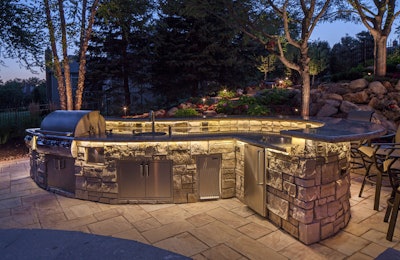 Photo: McKay Landscape Lighting
Photo: McKay Landscape LightingOutdoor lighting highlights your work and extends the time your busy clients have to enjoy their landscaping investment.
“There’s probably no more high-value, low-cost way to enhance a home’s curb appeal than with light,” says Nick Jacques, retail category and brand manager for Malibu Lighting. “It’s a great way for the landscaper to add a finishing touch to the landscape.”
Joe Densieski, owner of Nu Green Landscaping in Riverhead, New York, includes lighting as an option in every landscape plan he creates. He says 60 to 70 percent of his clients choose the option, an increase compared with a couple of years ago.
Densieski compares the growing popularity of outdoor lighting to what’s happened with landscape irrigation over the past two decades. Irrigation is part of every landscape project now, but in the ’70s and early ’80s it wasn’t common.
“Lighting is where irrigation was 15 or 20 years ago,” says Densieski, whose company specializes in lighting. “It’s an upscale extra in a landscape. In another 15 or 20 years lighting will be an automatic component. It’s about getting it out there and showing people the different things that can be done with it.”
Silhouettes, shadows and moonbeams
One of those things is a technique called moonlighting. It involves placing low-voltage lights in trees about 25 feet above the ground. Rays of soft illumination filter through the leaves, creating shadows on walkways, driveways or patios like the full moon would on a clear night.
Moonlighting probably evolved from the trend of putting spotlights in trees to temporarily illuminate yards for parties. That type of lighting was brighter and more functional than moonlighting, which is used to create a certain look and provides only enough light to allow someone to navigate the property, Densieski says.
Downlighting, in which a fixture directs light like a lamp shade, works well for lighting paths and walkways, Jacques says. This technique creates circles of light on the ground. You can also use fixtures that produce light patterns such as a group of stars or a crackle design.
The opposite technique – uplighting – is a good way to draw attention to the best elements of a landscape. Uplighting can illuminate a stunning waterfall, groups of plants or a beautiful tree, making it appear to glow in the dark. Jacques recommends uplighting your clients’ favorite features.
When lighting a planting bed in front of a home or business, you can use uplighting or create a more unusual effect with silhouetting or shadowing. By placing lights between the structure and the plants and pointing them at the wall, you’ll wash the face of the wall.








